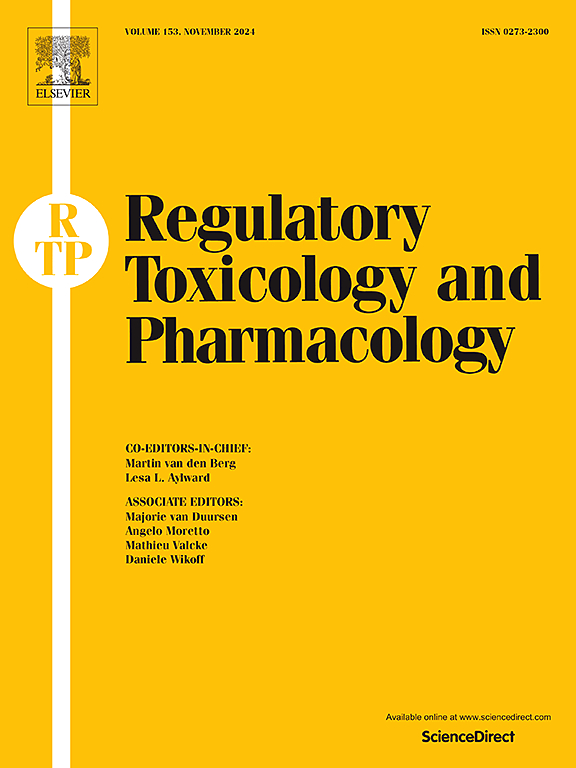Elucidation of 28 day repeated oral dose induced genotoxicity potential of nickel (II) oxide nanoparticles in wistar albino rats
IF 3
4区 医学
Q1 MEDICINE, LEGAL
引用次数: 0
Abstract
Nanotechnology has revolutionized industrial processing and human life by the applications of nanoparticles (NPs), especially the metal oxide ones. Nickel oxide (NiO) NPs have been used in applications including electronics and biosensors. Occupational and accidental exposure to these NPs for longer durations is apparent and the same may lead to significant health risks. In the present study, we have elucidated the genotoxic ability of NiO-NPs post repeated oral exposure for 28 days in Wistar albino rats at 50, 100, and 200 mg/kg body weight doses. A dose dependent percentage tail DNA was recorded in the peripheral blood lymphocyte, liver and bone marrow cells on rats at all the doses tested. The micronucleus and CA tests using bone marrow cells showed the prominent DNA damage potential of NiO-NPs corroborating the comet assay results. Primary interaction of NiO-NPs or nickel ions generated from NiO-NPs and secondary interaction of reactive oxygen species generated in response to NiO-NPs toxic insult with the DNA are the suspected reasons for observed genotoxicity. This study highlights the probability of DNA damaging effects in non-target organisms when exposed to NiO-NPs for a long time. Investigations to elucidate the NiO-NPs mediated adverse effects on terrestrial organisms are warranted.
阐明氧化镍纳米颗粒对wistar白化大鼠28天重复口服诱导的遗传毒性潜力
纳米技术通过纳米颗粒(NPs)的应用,特别是金属氧化物纳米颗粒的应用,使工业加工和人类生活发生了革命性的变化。氧化镍(NiO) NPs已广泛应用于电子和生物传感器等领域。职业和意外接触这些有害物质的时间较长是显而易见的,同样可能导致重大健康风险。在本研究中,我们已经阐明了NiO-NPs在Wistar白化大鼠中以50、100和200 mg/kg体重剂量反复口服28天后的遗传毒性能力。在所有剂量下,大鼠外周血淋巴细胞、肝脏和骨髓细胞中记录了尾DNA的剂量依赖性百分比。骨髓细胞微核和CA试验显示,NiO-NPs具有显著的DNA损伤潜力,证实了彗星试验的结果。NiO-NPs或NiO-NPs产生的镍离子的初级相互作用以及NiO-NPs毒性损伤产生的活性氧与DNA的次级相互作用被怀疑是观察到的遗传毒性的原因。本研究强调了长时间暴露于NiO-NPs时非目标生物DNA损伤效应的可能性。研究阐明NiO-NPs介导的对陆生生物的不利影响是必要的。
本文章由计算机程序翻译,如有差异,请以英文原文为准。
求助全文
约1分钟内获得全文
求助全文
来源期刊
CiteScore
6.70
自引率
8.80%
发文量
147
审稿时长
58 days
期刊介绍:
Regulatory Toxicology and Pharmacology publishes peer reviewed articles that involve the generation, evaluation, and interpretation of experimental animal and human data that are of direct importance and relevance for regulatory authorities with respect to toxicological and pharmacological regulations in society. All peer-reviewed articles that are published should be devoted to improve the protection of human health and environment. Reviews and discussions are welcomed that address legal and/or regulatory decisions with respect to risk assessment and management of toxicological and pharmacological compounds on a scientific basis. It addresses an international readership of scientists, risk assessors and managers, and other professionals active in the field of human and environmental health.
Types of peer-reviewed articles published:
-Original research articles of relevance for regulatory aspects covering aspects including, but not limited to:
1.Factors influencing human sensitivity
2.Exposure science related to risk assessment
3.Alternative toxicological test methods
4.Frameworks for evaluation and integration of data in regulatory evaluations
5.Harmonization across regulatory agencies
6.Read-across methods and evaluations
-Contemporary Reviews on policy related Research issues
-Letters to the Editor
-Guest Editorials (by Invitation)

 求助内容:
求助内容: 应助结果提醒方式:
应助结果提醒方式:


